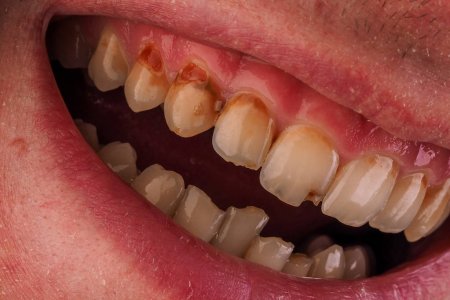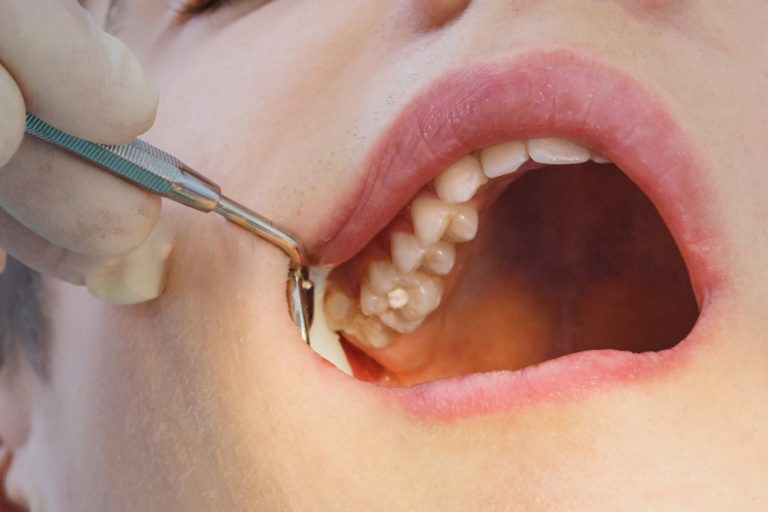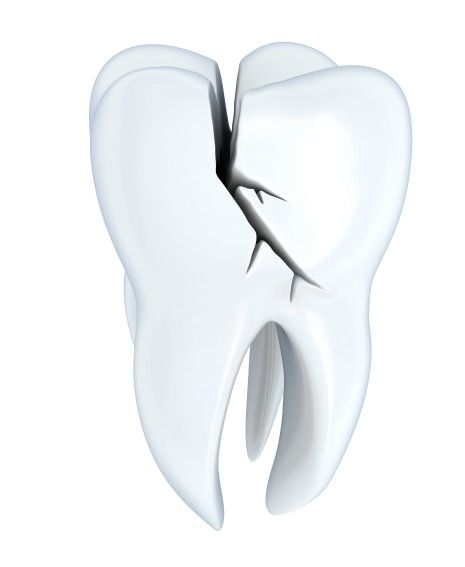Tooth Decay Dangers: How It Happens As its name implies, tooth decay is a condition in which the build-up of acidic material in a person’s mouth causes the outer layers of their teeth to slowly begin to erode and dissolve. Many things can contribute to a filling becoming chipped or broken. It can include tooth wear from grinding or clenching to bacteria leaking into the fillings' margins and causing decay or simply because the filling is old and a replacement is needed. Left untreated, a lost or chipped filling can lead to a root canal and possible tooth loss. Cracked tooth syndrome could be considered a type of dental trauma and also one of the possible causes of dental pain. One definition of cracked tooth syndrome is 'a fracture plane of unknown depth and direction passing through tooth structure that, if not already involving, may progress to communicate with the pulp and/or periodontal ligament.' Tooth abscess could lead to a life-threatening condition called meningitis. This illness is an inflammation of the membranes near the spinal cord and brain. If the bacterial infection is untreated, the virus could move into the bloodstream to the spinal cord and area around the brain. Meningitis could require lengthy hospitalization.
Cracked Tooth Repair
Whether your tooth cracks from an injury or general wear and tear, you can experience a variety of symptoms ranging from erratic pain when you chew your food to sudden pain when your tooth is exposed to very hot or cold temperatures. In many cases, the pain may come and go and your dentist may have difficulty locating the tooth causing the discomfort. If you experience these symptoms or suspect a cracked tooth, it’s best to see an endodontist as soon as possible.
Endodontists specialize in saving cracked teeth and will cater treatment to the type, location, and extent of the crack. The sooner your tooth is treated, the better the outcome. Once treated, most cracked teeth continue to function as they should, for many years of pain-free biting and chewing.
Cracked Tooth Repair; Danger Of Cracked Microwave Door. When a filling in a tooth exceeds 1/2 of the width of the tooth, you will be 3 to 4 times more likely to break the tooth. Now, this does not mean you will break all of these largely filled teeth. However, it means that when you have a large filling, you are at a significantly higher risk.
Endodontists are specialists in saving teeth. Learn more about why you should see an endodontist.
Explore more about the symptoms, causes, and treatments for cracked teeth.

Cracked teeth show a variety of symptoms, including erratic pain when chewing, possibly with the release of biting pressure, or pain when your tooth is exposed to temperature extremes. In many cases, the pain may come and go, and your dentist may have difficulty locating which tooth is causing the discomfort.
To understand why a cracked tooth hurts, it helps to know something about the anatomy of the tooth. Inside the tooth, under the white enamel and a hard layer called the dentin, is the inner soft tissue called the pulp. The pulp contains the tooth's nerves and blood vessels.
When the outer hard tissues of the tooth are cracked, chewing can cause movement of the pieces, and the pulp can become irritated. Eventually, the pulp will become damaged to the point that it can no longer heal itself.

The tooth will not only hurt when chewing but may also become sensitive to temperature extremes. In time, a cracked tooth may begin to hurt all by itself. Extensive cracks can lead to infection of the pulp tissue, which can spread to the bone and gum surrounding the tooth.
Chipped teeth account for the majority of dental injuries. Most chipped teeth can be repaired either by reattaching the broken piece of tooth enamel or by bonding a tooth-colored filling or crown in place. See your dentist as soon as possible after the injury to treat your chipped tooth and keep it from worsening.
There are many different types of cracked teeth. The treatment and outcome for your tooth depend on the type, location, and extent of the crack.
Craze Lines
Craze lines are tiny cracks that affect only the outer enamel. These cracks are extremely common in adult teeth. Craze lines are very shallow, cause no pain, and are of no concern beyond appearances.
Dangers Of Cracked Tooth
Fractured Cusp
When a piece of a tooth’s chewing surface breaks off, often around a filling, it’s called a fractured cusp. A fractured cusp rarely damages the pulp, and usually doesn’t cause much pain. Your dentist can place a new filling or crown over the damaged tooth to protect it.
If you've cracked a tooth and breathing through your mouth or drinking cold fluids is painful, bite on clean, moist gauze or cloth to help relieve symptoms until reaching your dentist’s office. Never use topical oral pain medications (such as Anbesol®) or ointments, or place aspirin on the affected areas to eliminate pain symptoms.
Cracked Tooth
A cracked tooth means a crack extends from the chewing surface of your tooth vertically toward the root. The tooth is not yet separated into pieces, though the crack may gradually spread. Early diagnosis is important in order to save the tooth. If the crack has extended into the pulp, the tooth can be treated with a root canal procedure and a crown to protect the crack from spreading.
However, if the crack extends below the gum line, it is no longer treatable, and the tooth cannot be saved and will need to be extracted. That’s why early treatment is so important. A cracked tooth that is not treated will progressively worsen, eventually resulting in the loss of the tooth. Early diagnosis and treatment are essential in saving these teeth.
Split Tooth
A split tooth is often the result of the long-term progression of a cracked tooth. The split tooth is identified by a crack with distinct segments that can be separated. A split tooth cannot be saved intact. The position and extent of the crack, however, will determine whether any portion of the tooth can be saved. In some cases, endodontic treatment may be performed to save a portion of the tooth.
Vertical Root Fracture
Vertical root fractures are cracks that begin in the root of the tooth and extend toward the chewing surface. They often show minimal signs and symptoms and may, therefore, go unnoticed for some time. Vertical root fractures are often discovered when the surrounding bone and gum become infected. Treatment may involve extraction of the tooth. However, endodontic surgery is sometimes appropriate if a tooth can be saved by removal of the fractured portion.

Unlike a broken bone, the fracture in a cracked tooth will not heal. In spite of treatment, some cracks may continue to progress and separate, resulting in loss of the tooth. Placement of a crown on a cracked tooth provides maximum protection but does not guarantee success in all cases.
The treatment you receive for your cracked tooth is important because it will relieve pain and reduce the likelihood that the crack will worsen. Once treated, most cracked teeth continue to function and provide years of comfortable chewing. Talk to your endodontist about your particular diagnosis and treatment recommendations.

While cracked teeth are not completely preventable, you can take some steps to make your teeth less susceptible to cracks.
- Don't chew on hard objects such as ice, unpopped popcorn kernels or pens.
- Don't clench or grind your teeth.
- If you clench or grind your teeth while you sleep, talk to your dentist about getting a retainer or other mouthguard to protect your teeth.
- Wear a mouthguard or protective mask when playing contact sports.
Danger Of A Cracked Tooth
Understanding Cracked Tooth Symptoms and Treatment
Learn about the symptoms and types of cracked teeth and how endodontists help patients avoid tooth extraction.

Visit the AAE YouTube Channel for more patient education videos to learn more about root canals and other endodontic procedures.
Although teeth are very strong, they can break under certain circumstances. Tooth enamel can sometimes be fractured or chipped by bad oral habits like chewing on hard items or munching on ice. Individuals who grind their teeth while sleeping or using their teeth as tools when opening things are at a heightened risk of suffering a fractured tooth. Restorative dentistry Marco Island treats damaged or fractured tooth to prevent severe complications and prevent bacteria from thriving in the location of a damaged tooth.
Symptoms Of A Cracked Tooth
Cracked Teeth and You
How Do Teeth Break?
Many things can cause teeth to crack, such as:
- Enormous pressure from extreme tooth grinding
- Large fillings that weaken the tooth
- Chewing or biting on hard objects
- Injury to the chin or lower jaw
- Gum disease
- Sudden changes in mouth temperature
- Using teeth as tools to open bottles and packages and to hold things
Complications of an Untreated Cracked Tooth
You have a better chance of saving your cracked tooth if you get it treated sooner by your dentist. If you don’t get it treated immediately, the damage will only get worse over time, and it allows bacteria to enter the softer layer of tissue under the enamel and soft inner part of the tooth. The bacteria will lead to an infection and an abscess, a pocket of infected material can form. Abscesses can cause pain and if your broken tooth is left untreated, the infection can spread to other parts of your body, which can cause serious complications.
Treatment for Cracked Tooth
Danger Of Cracked Tooth
Treatment for a cracked tooth depends on the location and the extent of the damage. Treatment options include:
- Dental bonding
- Filling
- Dental crown
- Gluing on the chipped or broken part of the tooth
Schedule an Appointment Today!
Don’t wait for complications to occur before having your cracked tooth treated. Island Paradise Dental offers all types of restorative dentistry Marco Island procedures. If you have issues with a broken, cracked, or chipped tooth, schedule an appointment with us.
